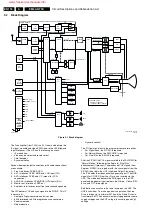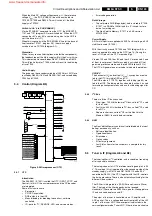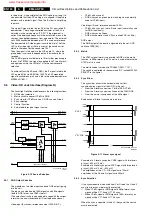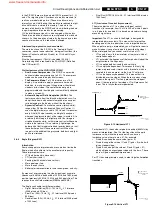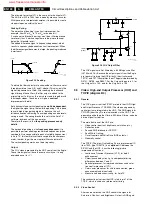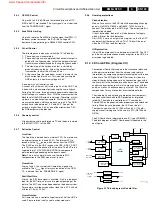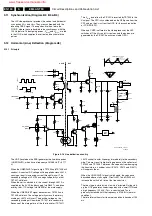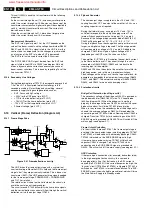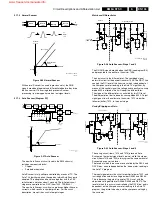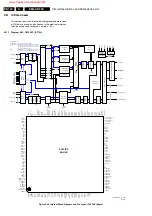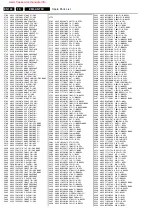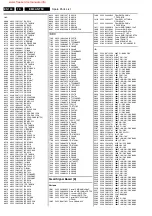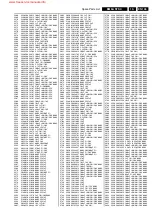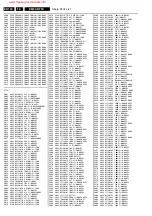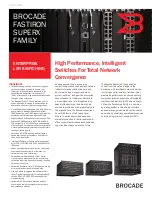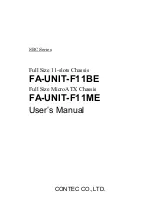
Circuit Descriptions and Abbreviation List
EN 132
9.
This coil (L5422) consists of a transformer with the following
properties:
As the current through the coil 1-2 increases (smaller picture
width), the current through coil 3-4 decreases. Because of the
transformer characteristic a higher voltage will be subjected to
coil 3-4, which will counteract the current. The current will
diminish even further.
When the current through coil 1-2 diminishes (larger picture
width), the current through coil 3-4 increases.
Beam-current Correction
The 'EHT-info' signal at point 10 of the LOT depends on the
value of the beam-current and the voltage from divider R3450,
R3451, and C2450. This signal is fed to the HOP to trim the
contrast, and to compensate for the changes in picture-width
as a function of the EHT-info, when EHT is decreased.
The 'EHT-info' is also used to correct the EW-current.
The 'DYN-FASE-CORR' signal, derived from the 'EHT-info'
signal, is fed to the HOP via C2455 (see diagram A8) and
drives a dynamic phase correction necessary because of
beam-current variations. This is done by regulating T
ON
of the
line transistor TS7421.
9.12.4 Secondary Line Voltages
During the blocking time of TS7421, the magnetic energy of coil
1-5 of the LOT is transferred to electrical energy in the
secondary winding. Via rectifying and smoothing, several
secondary supply voltages are generated, such as:
•
EHT, Focus and Vg2-voltage
•
+200V for the CRT panel (pin 8 LOT)
•
+11D for the line deflection (pin 12 LOT)
•
+13V-LOT for the frame deflection (pin 6 LOT)
•
-15V-LOT for the frame deflection (pin 3 LOT)
•
Filament voltage (pin 9 LOT)
9.13 Vertical (Frame) Deflection (Diagram A4)
9.13.1 Frame Stage Drive
Figure 9-21 Frame deflection circuitry
The HOP drives the frame output stage with a symmetrical
saw-tooth voltage. Since the HOP is 'cold' and the frame output
stage is 'hot,' they are galvanically isolated. This is done via a
transformer (5621.) The HOP generates three signals needed
for the frame output stage: FRA, FRAMEDRIVE-
and TILT (for rotation.)
The rotation circuit is kept on the 'cold' side of the chassis, to
avoid the cost of an extra optocoupler.
The circuit around IC7440 will amplify the frame drive signals
and the vertical deflection current will flow through the vertical
deflection coil via the output stage IC7620.
9.13.2 Flyback Generator
The frame output stage is supplied via the +13 V and -15 V
coming from the LOT. The output of the amplifier is 0 V
DC
, so a
coupling capacitor is not required.
During the (forward) scan, a supply of +13 V and -15 V is
sufficient to respond to the slowly changing current. The
internal flyback generator puts a voltage of -15 V on pin 3.
Because of the voltage drop over zener diode D6622 (8.2 V),
C2622 will be charged to 19 V: 13 + (15 - 8.2 - 0.7) V.
During the flyback scan, the change in current-per-time is much
larger, so a higher voltage is required. The flyback generator
will now generate a voltage of +13 V on pin 3. Added to the
charge on C2622 this will give a flyback voltage of 32 V
(depending on the CRT size, this value can differ.)
The amplifier IC (IC7620, pin 5) supplies the saw-tooth current
to the frame deflection coil. The current through this coil is
measured via R3620//R3621//R3622 and fed back to the
inverting input of the amplifier.
R3624 and C2624 on the output of the amplifier form a filter for
high frequencies, and, in this way, prevent oscillations.
Peak voltages on the output, as a result of a possible flash, for
example, are damped by the clamp circuit consisting of D6619,
C2627, and R3627. The network consisting of R3625, R3626,
R3629, and C2629 forms an extra damping circuit.
9.13.3 Protection circuits
Bridge Coil Protection (see Diagram A3)
The secondary voltage of the bridge coil L5422 is guarded at
the diode modulator (D6421/6422) via a 10 V zener diode
(6499 on diagram A4.) When the bridge-coil is working
properly, the average voltage on D6422 is such that this zener
diode will conduct. It will drive TS7652 into saturation.
When, for any reason, the secondary side of the bridge coil is
shorted, the average voltage on D6422 will drop below the
zener-voltage, and TS7652 will block. Now capacitor C2642 is
charged. Transistor TS7443 starts conducting and the SUP-
ENABLE signal is grounded via R3403. This will switch 'off' the
main supply (see diagram A1.)
Frame Output Protection
Via the circuit built around TS7641, the frame output stage is
guarded. If the frame output stage is working properly, TS7641
and TS7652 will both conduct, and thereby discharge C2642.
TS7443 is blocked, so the SUP-ENABLE signal is 'high.'
If there are frame pulses missing, TS7641 will block and
capacitor C2642 is charged. Transistor TS7443 starts
conducting and the SUP-ENABLE signal is grounded via
R3403. This will switch 'off' the main supply (see diagram A1.)
ARC Protection
If there are 'open' connections (for example, bad solder joints)
in the high-energy deflection circuitry, this can lead to
damaging effects (fire.) For that reason, the E/W current is
sensed (via 3479//3480.) If this current becomes too high, the
'thyristor' circuit (TS7653 and TS7654) is triggered. TS7442 is
switched 'on' and TS7443 is forced into conduction. The 'SUP-
ENABLE' signal is now shorted to ground level, which will force
the Main Power Supply into Standby mode.
CL 26532041_078.eps
170402
HOT
COLD
3633
3631
7611
7612
7620
1625
3640
FRAME
DEFL.
COIL
1620
ROTATION COIL
+8V
7440-A
7450-A
7450-B
+8V
+8V
+11V
TDA 7052
TILT 25
2
1
3
FD-
FD+
E/W DRIVE
HOP
FRAME
E/W
HFB-X-RAY-PROT
7455
3642
+13VLOT
-15VLOT
3628
V-SHIFT
+8V
5621
7641
3639
2603
3623
3620
2653
7482
E/W
E/W
2
1
5
4
www.freeservicemanuals.info
Summary of Contents for EM5A NTSC
Page 6: ...Direction for Use EN 6 EM5A NTSC 3 3 Direction for Use www freeservicemanuals info ...
Page 7: ...Direction for Use EN 7 EM5A NTSC 3 www freeservicemanuals info ...
Page 8: ...Direction for Use EN 8 EM5A NTSC 3 www freeservicemanuals info ...
Page 9: ...Direction for Use EN 9 EM5A NTSC 3 www freeservicemanuals info ...
Page 10: ...Direction for Use EN 10 EM5A NTSC 3 www freeservicemanuals info ...
Page 11: ...Direction for Use EN 11 EM5A NTSC 3 www freeservicemanuals info ...
Page 12: ...Direction for Use EN 12 EM5A NTSC 3 www freeservicemanuals info ...
Page 13: ...Direction for Use EN 13 EM5A NTSC 3 www freeservicemanuals info ...
Page 14: ...Direction for Use EN 14 EM5A NTSC 3 www freeservicemanuals info ...
Page 15: ...Direction for Use EN 15 EM5A NTSC 3 www freeservicemanuals info ...
Page 16: ...Direction for Use EN 16 EM5A NTSC 3 www freeservicemanuals info ...

